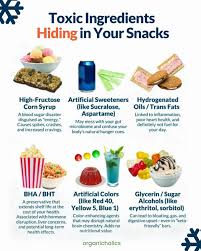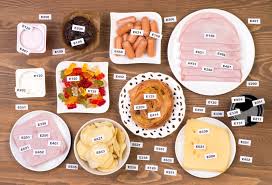
10 Toxic Ingredients Hiding in Your Favorite Snacks
You grab a bag of chips or a colorful candy bar, thinking it’s just a harmless treat. But what if that delicious bite is hiding something harmful? Many popular snacks contain ingredients that, while approved for consumption in small amounts, have been linked to serious health concerns when eaten frequently.
Here’s a closer look at 10 toxic ingredients that may be lurking in your favorite snacks—and why you should consider reading labels more carefully.
1. High-Fructose Corn Syrup (HFCS)
Found in: Soft drinks, granola bars, cookies, and sweetened yogurts
This cheap sweetener is used widely in processed foods and beverages. Studies suggest that high consumption of HFCS can lead to insulin resistance, obesity, type 2 diabetes, and increased risk of fatty liver disease. Unlike natural sugars, HFCS is absorbed more rapidly, putting extra stress on your liver and blood sugar regulation.
2. Artificial Colors (e.g., Red 40, Yellow 5, Blue 1)
Found in: Candies, chips, cereals, sports drinks
These synthetic dyes make snacks visually appealing, especially to children. But many artificial colors are derived from petroleum and have been linked to hyperactivity in kids, allergic reactions, and even potential carcinogenic effects. In fact, some of these dyes are banned in Europe but still widely used in the U.S.
3. Monosodium Glutamate (MSG)
Found in: Flavored chips, instant noodles, frozen snacks
MSG is a flavor enhancer that can trigger symptoms like headaches, nausea, and fatigue in sensitive individuals—a condition sometimes called “Chinese Restaurant Syndrome.” While the FDA considers it safe in small quantities, many experts warn about its potential to overstimulate the brain’s glutamate receptors.
4. Partially Hydrogenated Oils (Trans Fats)
Found in: Packaged baked goods, microwave popcorn, crackers
Trans fats are known to raise bad cholesterol (LDL) and lower good cholesterol (HDL), increasing the risk of heart disease and stroke. Though many manufacturers have phased out trans fats, they still exist in some processed snacks—so always check for “partially hydrogenated” oils on the label.
5. Sodium Nitrite and Nitrate
Found in: Processed meats like beef jerky, sausage snacks, and lunchables
Used to preserve color and shelf life, these additives can form nitrosamines, compounds linked to cancer, particularly colorectal cancer. Even “natural” versions like celery powder may pose similar risks, according to some research.
6. BHA and BHT (Butylated Hydroxyanisole and Butylated Hydroxytoluene)
Found in: Chips, snack mixes, preserved meats
These synthetic preservatives prevent fats from spoiling, but they’re considered possible human carcinogens by the World Health Organization. Long-term exposure has raised concerns about hormonal disruption and liver damage in lab animals.
7. Propyl Gallate
Found in: Chewing gum, meat snacks, chicken-flavored crackers
This antioxidant additive is used to extend shelf life, but some studies suggest it may cause endocrine disruption and increase the risk of cancer. It often appears alongside BHA and BHT, compounding potential toxicity.
8. Potassium Bromate
Found in: Some packaged breads, rolls, and baked snack products
Used to strengthen dough and improve texture, potassium bromate has been linked to kidney and thyroid tumors in animal studies. Though banned in many countries, it’s still allowed in the U.S. in small amounts—yet trace residues can remain in finished products.
9. Aspartame and Other Artificial Sweeteners
Found in: “Sugar-free” gums, diet sodas, protein bars
While promoted as a healthier alternative to sugar, aspartame and similar sweeteners (like sucralose and acesulfame potassium) are controversial. Some studies suggest potential links to mood disorders, headaches, and even certain cancers with long-term exposure.
10. TBHQ (Tertiary Butylhydroquinone)
Found in: Fast food fries, crackers, chips, frozen snacks
TBHQ is a synthetic preservative used to prevent oils from going rancid. Though considered safe in low doses, high concentrations have caused tumors and liver enlargement in animal studies. It may also affect immune system function over time.
What You Can Do
Avoiding all processed foods isn’t realistic for most of us, but you can reduce your exposure to these toxic ingredients by:
-
Reading labels carefully: Learn to recognize these harmful additives by name.
-
Choosing whole, minimally processed snacks: Think fruits, nuts, air-popped popcorn, and homemade granola.
-
Shopping organic when possible: Organic certification often restricts the use of many synthetic additives.
-
Preparing your own snacks: Homemade treats let you control every ingredient.
Final Thoughts
Just because a snack is popular doesn’t mean it’s safe. Many ingredients approved for use decades ago are now under renewed scrutiny. Making smarter choices doesn’t mean you have to give up snacking—it just means choosing better snacks that nourish your body instead of harming it.
Stay informed, stay healthy—and snack smarter.
